For barbecue beginners and those with small households, the idea of smoking an entire beef brisket can be daunting, expensive, and potentially wasteful. Clever pitmasters reach for brisket’s little brother—the chuck roast, for an inexpensive, entry-level cut of meat, which delivers a very similar eating experience in a smaller package.
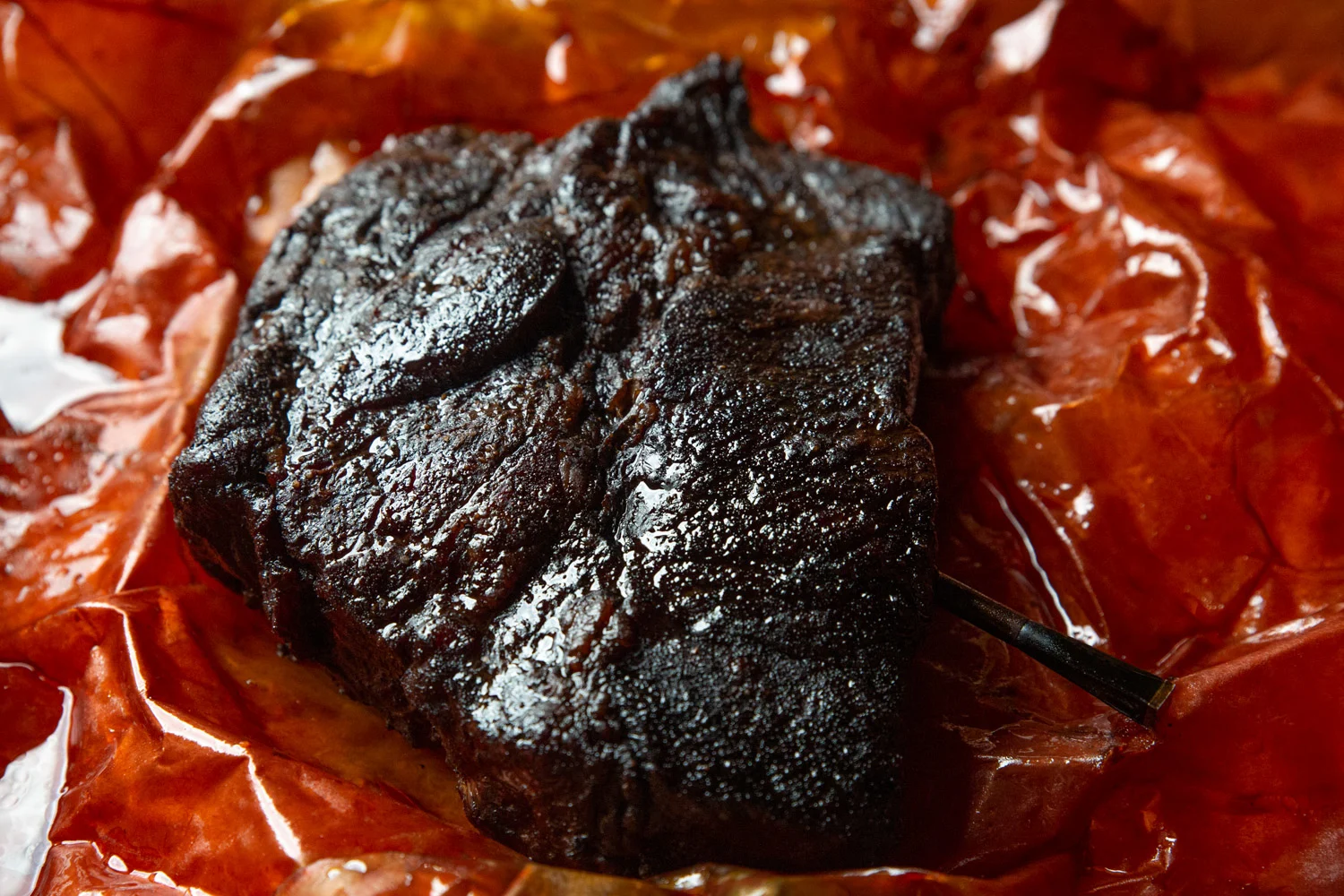
As a Texas chef and caterer, I’ve smoked many beef chuck roasts through the years and this step-by-step tutorial will reveal the secrets to ultra juicy meat and excellent smoke flavor that anyone can replicate in their own backyard.
This step-by-step tutorial will help you easily master smoked chuck roast, and here is what we will cover.
Table of Contents
- How Long To Smoke A Chuck Roast Per Pound
- How Long Does it Take to Smoke a Chuck Roast at 225 degrees?
- Where do the Variations in Cook Time for a Smoked Chuck Roast Come From?
- Where To Buy A Chuck Roast
- How To Prepare Your Smoker for Chuck Roast
- What Wood is Best for Smoking Beef?
- How to Trim a Chuck Roast for Smoking
- How To Dry Brine a Chuck Roast
- Dry Rub For Beef Chuck Roast
- How to Smoke Beef Chuck Roast
- Resting the Wrapped Chuck Roast (Oven vs. Igloo Cooler)
- How To Slice Smoked Chuck Roast
The first thing you’ll need to know is how long to smoke chuck roast per pound, as well as what temperature to maintain in your smoker for the perfect cook.
How Long To Smoke A Chuck Roast Per Pound
Smoked Chuck Roast is smoked at 225° for 2 hours per pound, or 250° for 1 ½ hours per pound. This does not include time for resting the meat, usually 1-2 hours for best results.
Best results are achieved by cooking to temperature, not to time. Smoked Chuck Roast should be cooked to 195 degrees, and rested for at least 1 hour. (My full procedure for ultra juicy chuck roast includes wrapping the meat at 170 degrees).
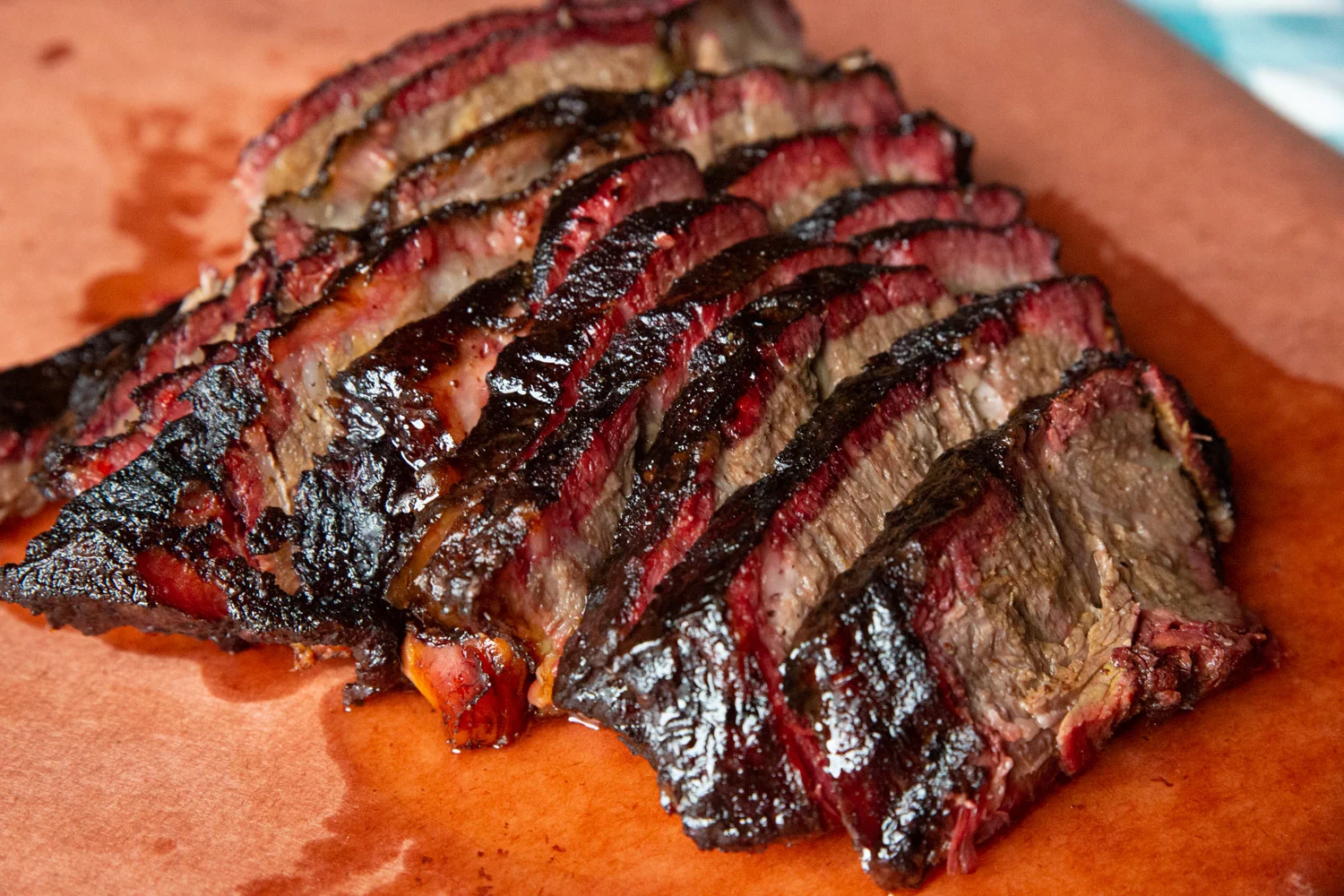
How Long Does it Take to Smoke a Chuck Roast at 225 degrees?
A 3-4 pound chuck roast will take 6-7 hours, plus 1 hour of resting time.
Where do the Variations in Cook Time for a Smoked Chuck Roast Come From?
Variations in your specific cook time come from temperature fluctuations in the smoker, as well as whether you choose to wrap the chuck roast (which will be demonstrated later in this tutorial). What qualities you are looking for in the final product will also affect how long you smoke the chuck roast…
For a sliced chuck roast that resembles sliced brisket, you will cook to an internal temperature of 195° or for pulled style meat you will need to cook to 205°.
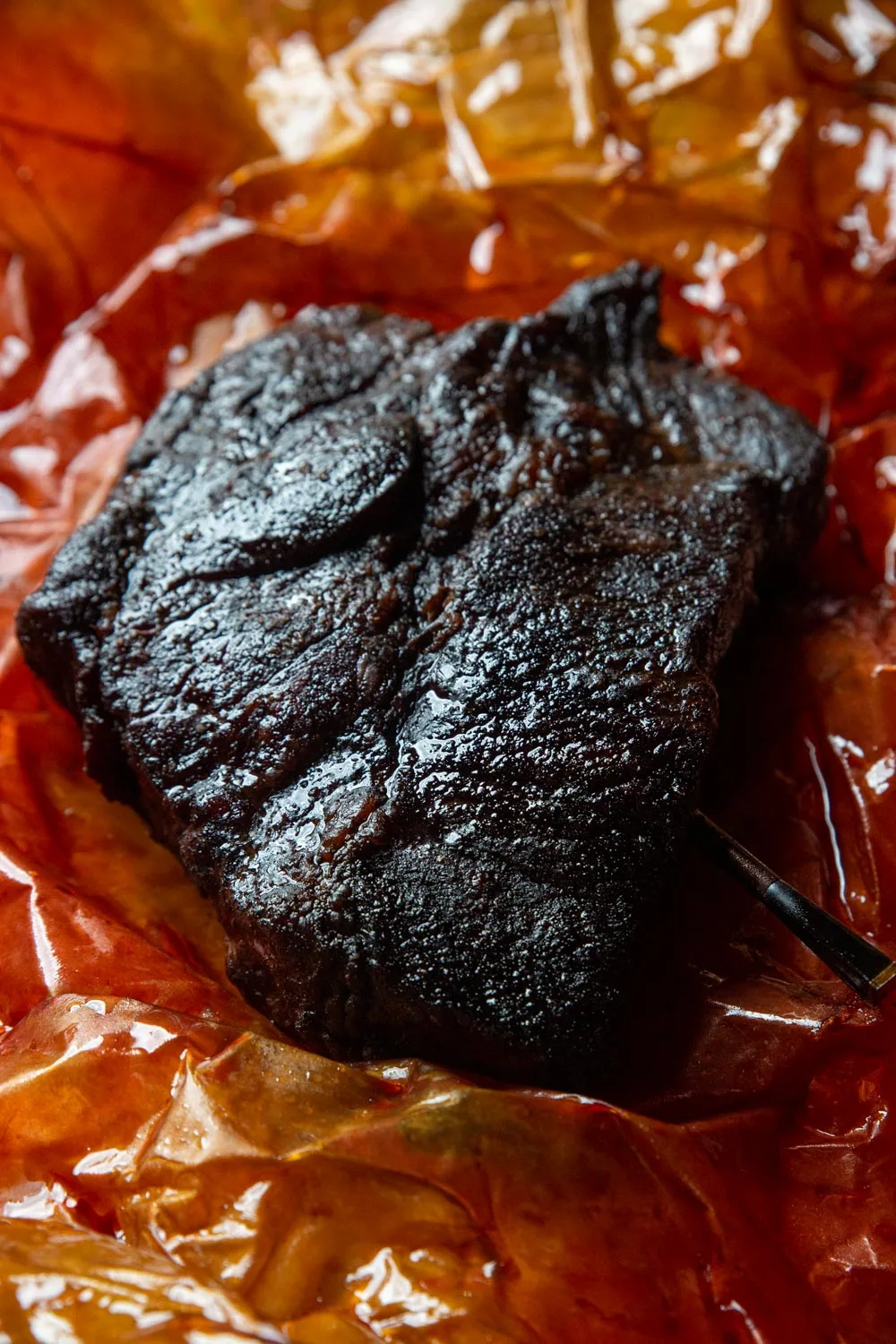
Where To Buy A Chuck Roast
Fortunately, chuck roast is one of the easiest cuts of beef to find. Since it is essentially the same cut as pot roast you can find it at basic grocery stores and certainly your favorite butcher shop or big box stores like Costco and Sam’s Club carry chuck roast.
Like any cut of beef, the grades go in this ascending order – Select, Choice, Prime
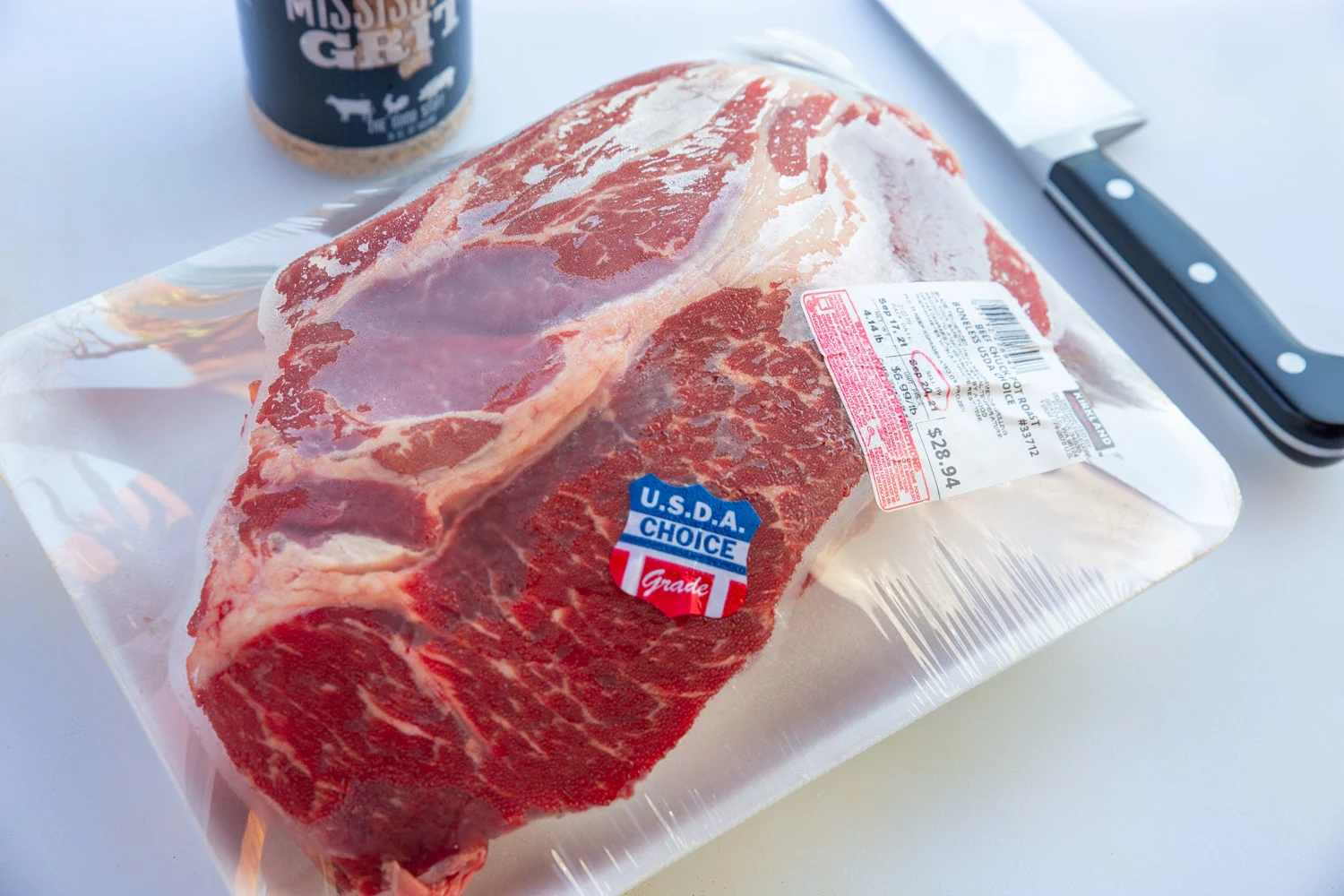
Choice is the lowest grade but what most of us will be purchasing at our local grocery store. Select or Prime can be found in specialty grocers and Costco. Higher grades of meat are associated with better flavor and tenderness, but with chuck roast, a choice grade cut is perfectly suitable for smoking.
(Links are affiliate links to products we think are helpful and we may receive a small commission, at no cost to you, if purchased.)
How To Prepare Your Smoker for Chuck Roast
We use our RecTeq 1250 pellet smoker to smoke the majority of our meat and that is what we will use in this tutorial.
You can use a pellet smoker like ours, a traditional offset smoker, a Big Green Egg or whatever smoker you have handy. Just make sure that whatever you’re using provides indirect heat and lots of smoke. The smoker should be prepped with clean grill grates and be ready to receive meat.
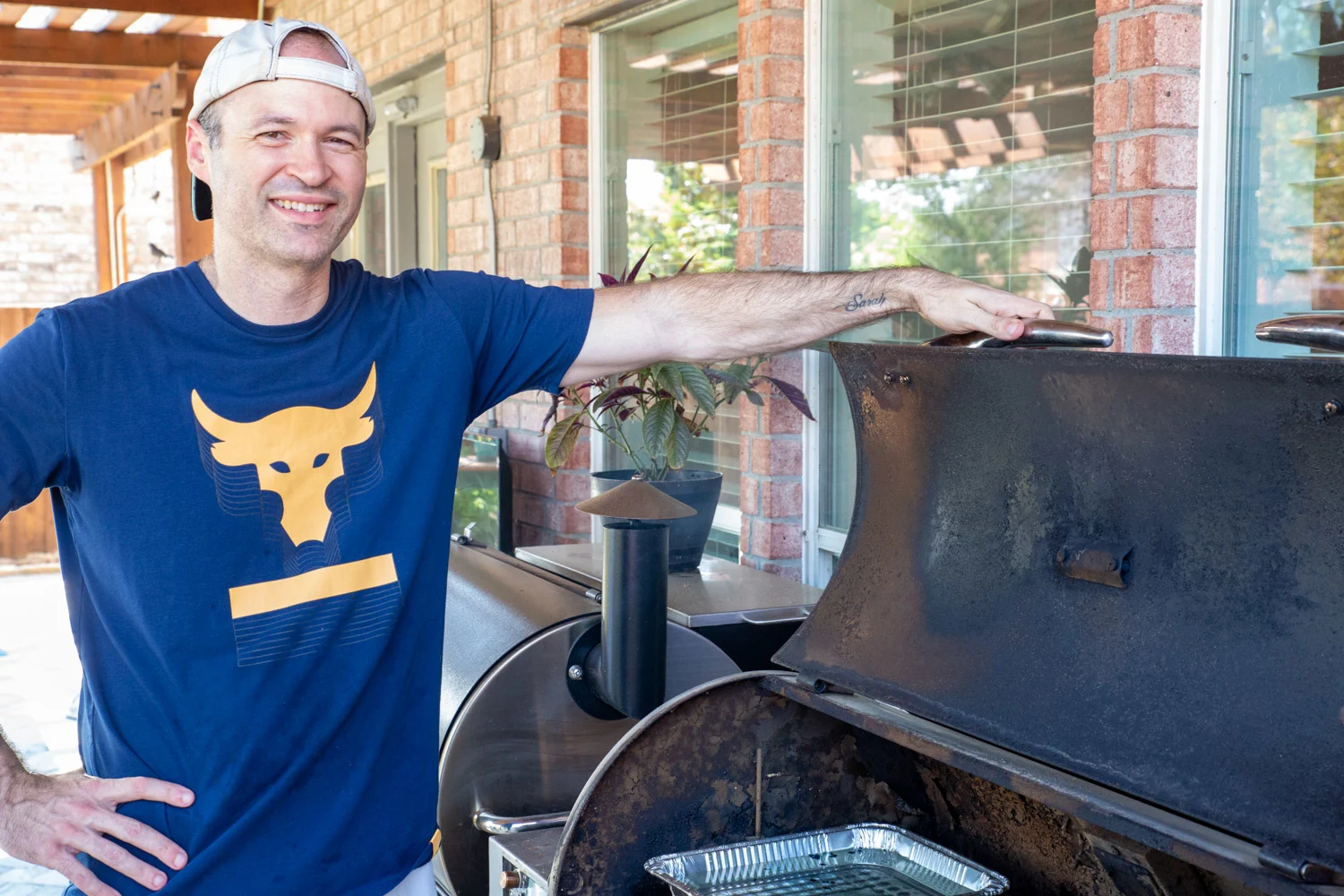
Offset smokers should start their fire and have wood nearby for adding to the wood box. Pellet Smokers should freshly be filled with pellets.
Bring the temperature of the smoker up to 225 degrees.
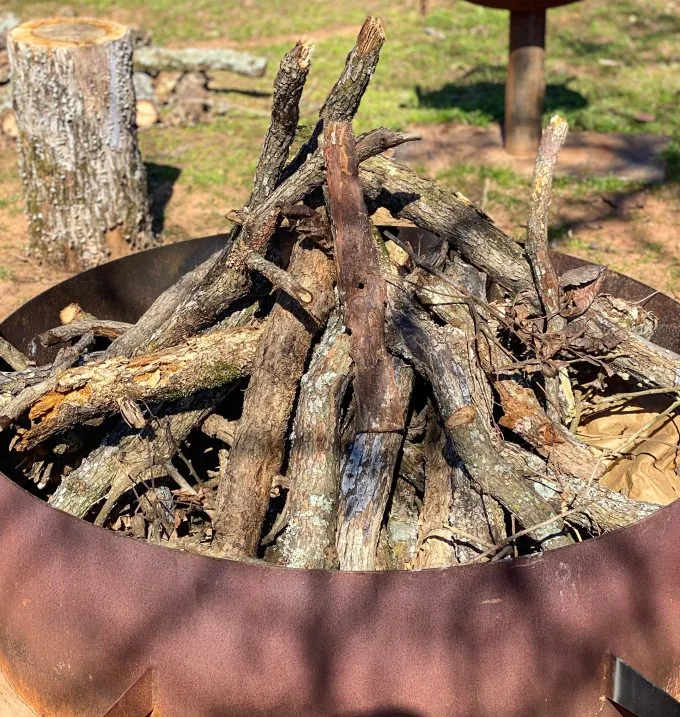
What Wood is Best for Smoking Beef?
Traditional beef smoking woods such as Oak, Pecan, Hickory, Peach, and Mesquite Blends are excellent to smoke chuck roast.
Our favorite pellets for smoking any type of beef are the Lumberjack Competition Blend Pellets. We also enjoy Bear Mountain Pellet Blends in traditional beef varieties. Whether you’re smoking with pellets, wood, or wood chips, the choice of wood is a personal preference. We encourage everyone to try different types of wood and pellets to see which one is your personal favorite.
Adding A Water Pan to the Smoker
We put a water pan into our Pellet Smoker because it helps to even out the temperatures in the cooking chamber. By doing this, you can ensure that your smoked chuck roast cooks as evenly as possible—and it doesn’t have to be anything high-tech at all. We use a basic foil pan filled with scorching hot water.
Why do you fill it with hot water? I’m glad you asked. Filling it with hot water will allow the water to evaporate into your smoke chamber faster. This works because you’re starting with water at a higher temperature and therefore the water doesn’t have to heat up as much as putting cold tap water into the chamber.
How to Trim a Chuck Roast for Smoking
The first thing we do in this smoked chuck roast recipe is simple. Cut off the vacuum-sealed wrapping that your chuck roast comes in and pat dry.
Whatever you do, do not rinse the chuck roast off in the sink. Studies have shown that this can spread bacteria around your kitchen. Instead, just use a paper towel to pat dry your meat.
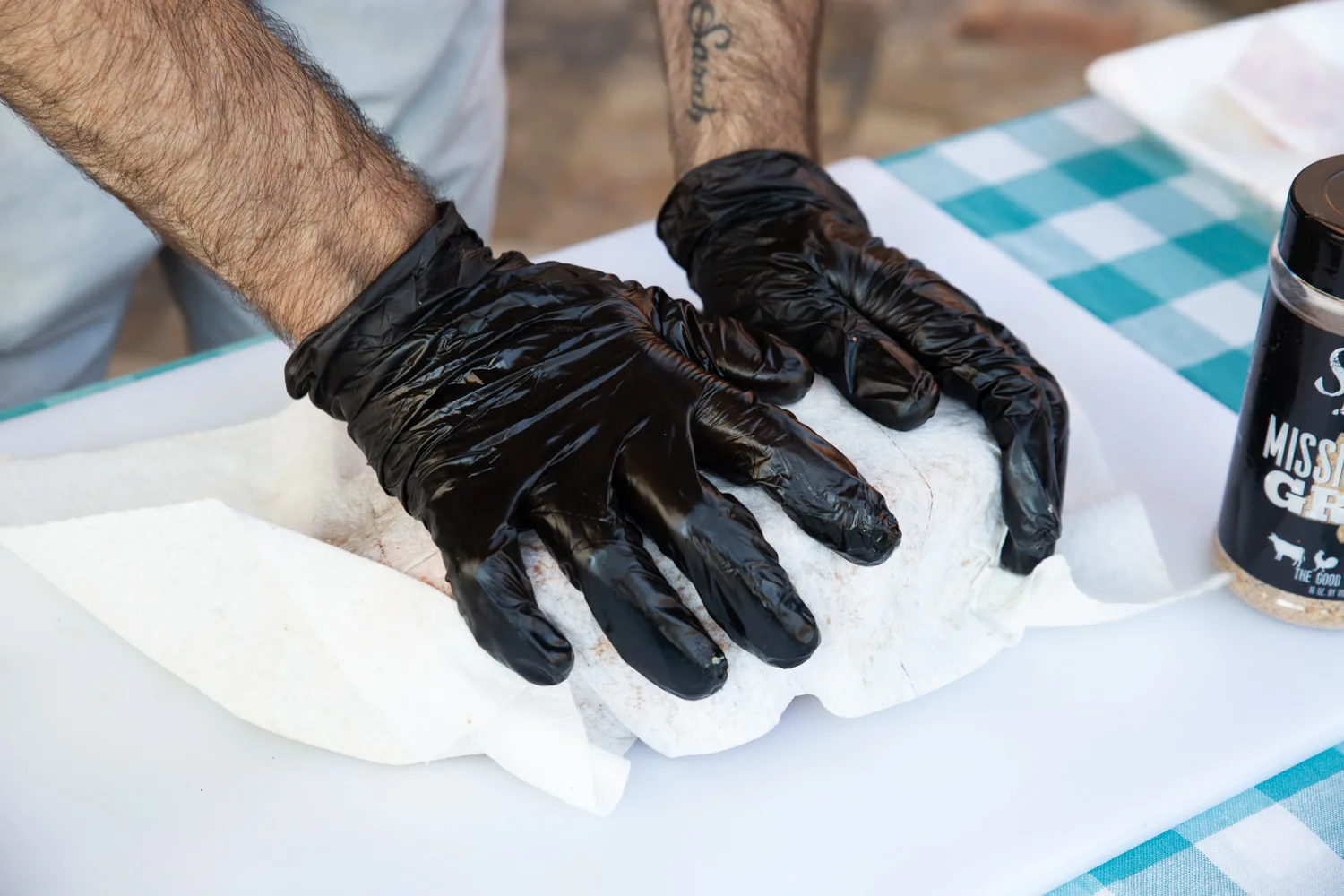
Unlike brisket, the great thing about smoking a beef chuck roast is that there is very little, if any, trimming that you have to do to it. The smoked beef chuck roast from the recipe video didn’t need any trimming whatsoever, which is common—let’s find out why.
Intramuscular Fat and Intermuscular Fat
Intramuscular fat is located within the meat and is referred to as marbling in the meat industry. This is the good fat that melts during the cook contributing to juicy meat and excellent flavor. Beef chuck roast has a lot of this intramuscular fat, which does not need to be trimmed out. The trick is making sure that all that fat renders out into liquid fat in your final smoked chuck roast.
There is also going to be intermuscular fat, the fat that separates the muscles. Chuck roast contains intermuscular fat because it is comprised of several different muscles.
Intermuscular fat is the fat that is chewy and will never break down all of the way. It will just soften and become chewy if you try to eat it. We’ve all had that chewy piece of meat that tires out our jaw and that was more than likely a piece of intermuscular fat.
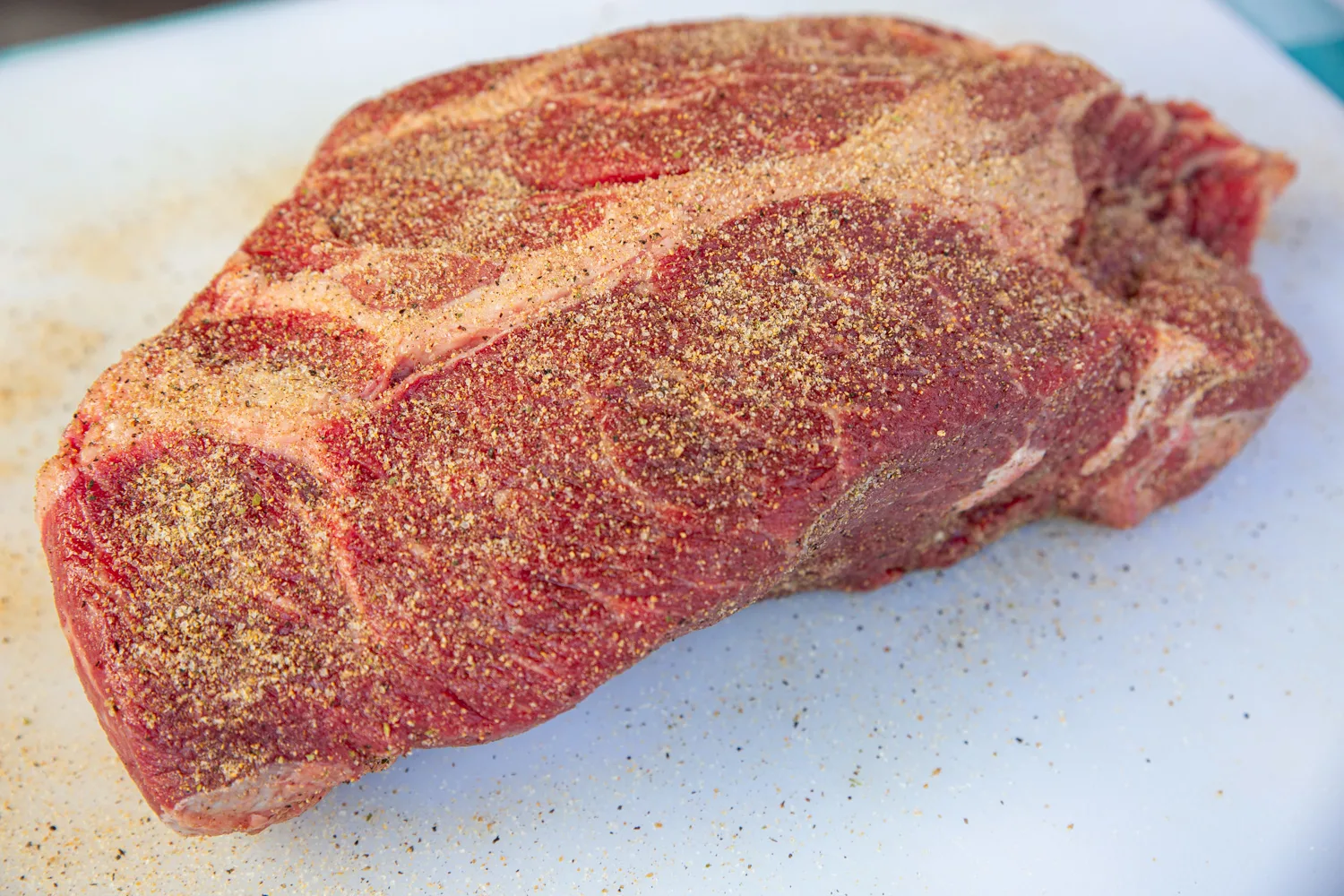
You’ll notice this type of fat right away within your chuck roast as it will be very firm to the touch and typically runs through the middle of your meat like a web. Don’t worry about cutting it out or trimming it, because it’s holding the roast intact and once the cook is done it is easy to pull the meat and remove these intermuscular fat beds.
In summary, no necessary trimming is typically needed in a chuck roast as you might find in other cuts of meat.
Now, you have 2 options depending on if you’re prepping your chuck roast to smoke the night before or the morning of your party, whether or not to dry brine.
How To Dry Brine a Chuck Roast
If you’re preparing your beef roast the night before you plan on smoking it, you can lightly salt the exterior with kosher salt and allow it to dry brine overnight in your refrigerator. Make sure and cover the meat after salting it and before you put it into your refrigerator overnight—we accomplish this by wrapping it in saran wrap, aluminum foil, or placing the meat in a disposable catering tin and tenting it with foil.
Dry brining the chuck roast is going to draw the water out from your beef and dissolve the salt. The beef will then reabsorb that salt solution into your meat, enhancing the flavor, and breaking down some of the muscle fibers resulting in even more tenderness.
There is a point of diminishing returns, so all you want to do is dry brine it overnight. If you dry brine for too long, such as several days, you risk the meat becoming mushy. Overnight up to 24 hours is the perfect dry brine timeline.
And if you aren’t able to salt it the night before, don’t worry because there are many times, we either forget or just don’t have the time. Dry brining is an optional step that can boost flavor if you make plans early to complete the process.
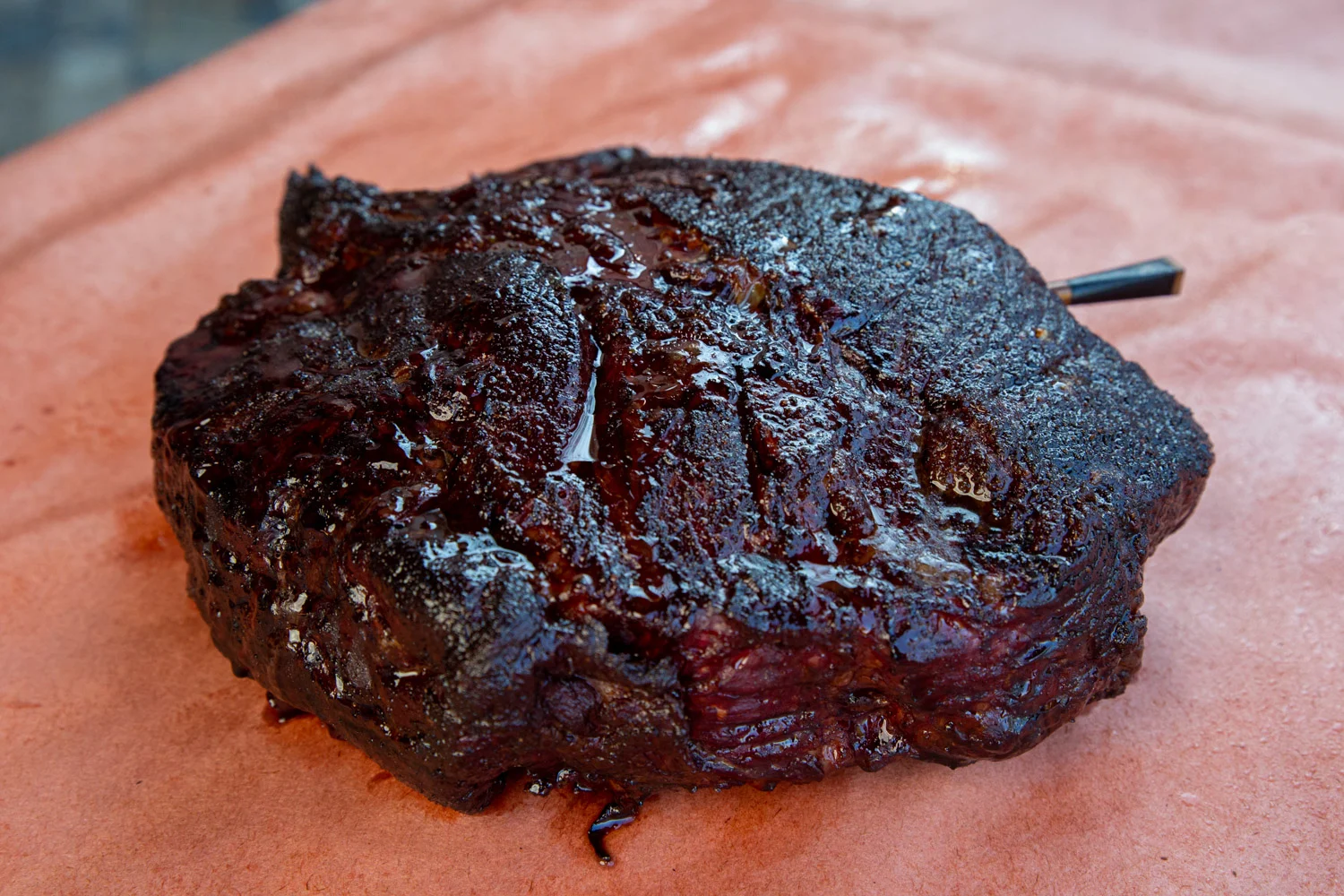
Dry Rub For Beef Chuck Roast
Now we’re going to season the meat. You can use whatever kind of rub you’d like but we prefer to use a beef rub with the main ingredients of kosher salt, pepper, garlic powder, and onion powder. Below is my personal recipe for Texas-style beef rub.
When you season your chuck roast, you want to steer clear of covering it fully from top to bottom. I’ve seen some recipes and YouTubers that will give it an airtight coating of the rub. Their version of a good coating is to cover the meat until you can barely see it under the rub.
This is a huge mistake as it does two things, it keeps the smoke from penetrating into your chuck roast and it prevents the bark from forming.
You can watch the video playing on this page to see how much we season our chuck roast.
How to Smoke Beef Chuck Roast
The smoking process is a breeze. Once you’ve prepped your smoker and chuck roast, all that is really left is the time, temperature, and wrapping of your meat.
Bring the internal temperature of the smoking chamber to 225°-250°.
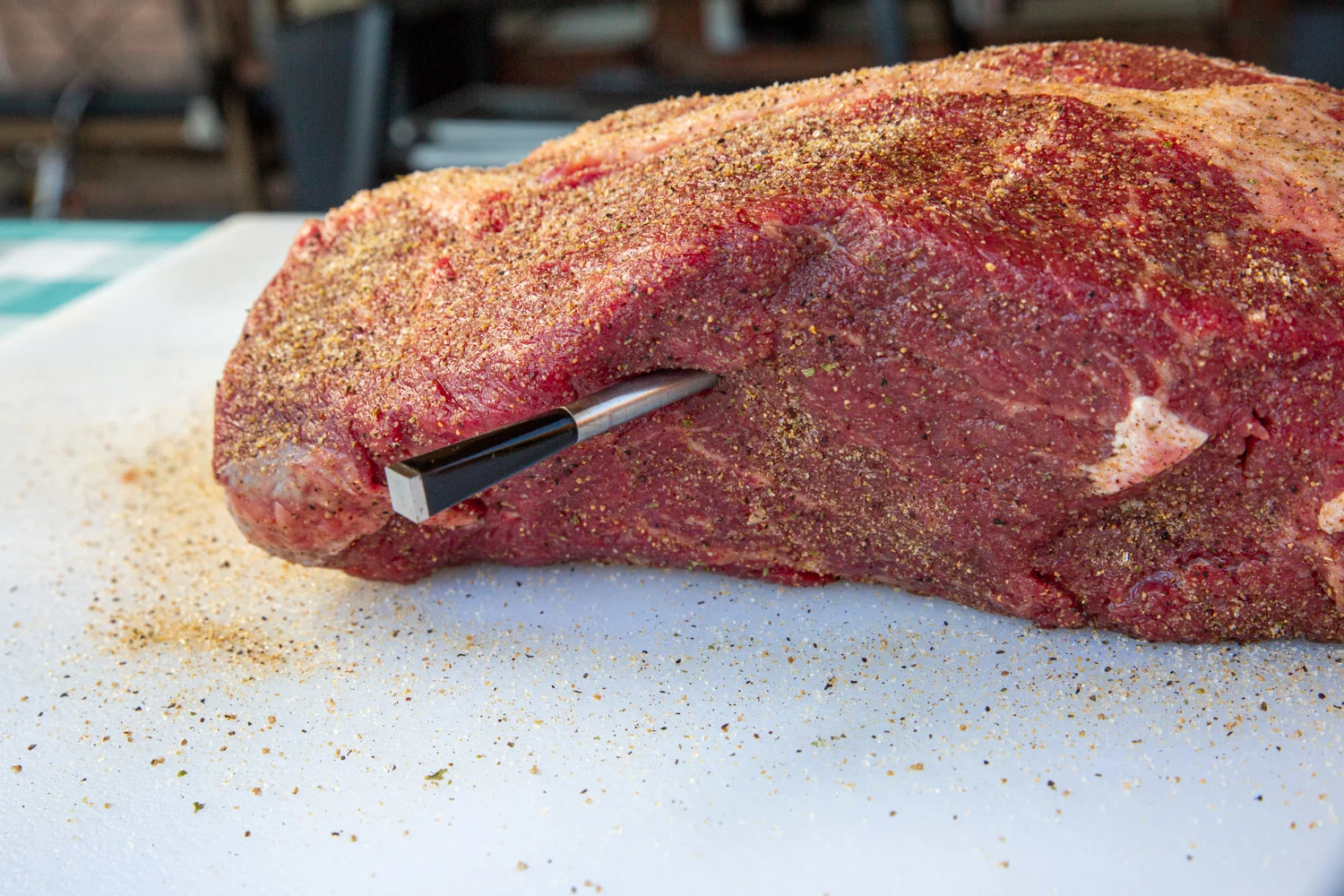
Probing the Chuck Roast with a Meat Thermometer
Once you’ve put your meat in the smoker, you’ll want to place a temperature probe in the middle of the roast in the thickest area. We use our Meater Wireless Digital Thermometer for this cook. (Using this link will give our readers 10% off the Meater probe.)
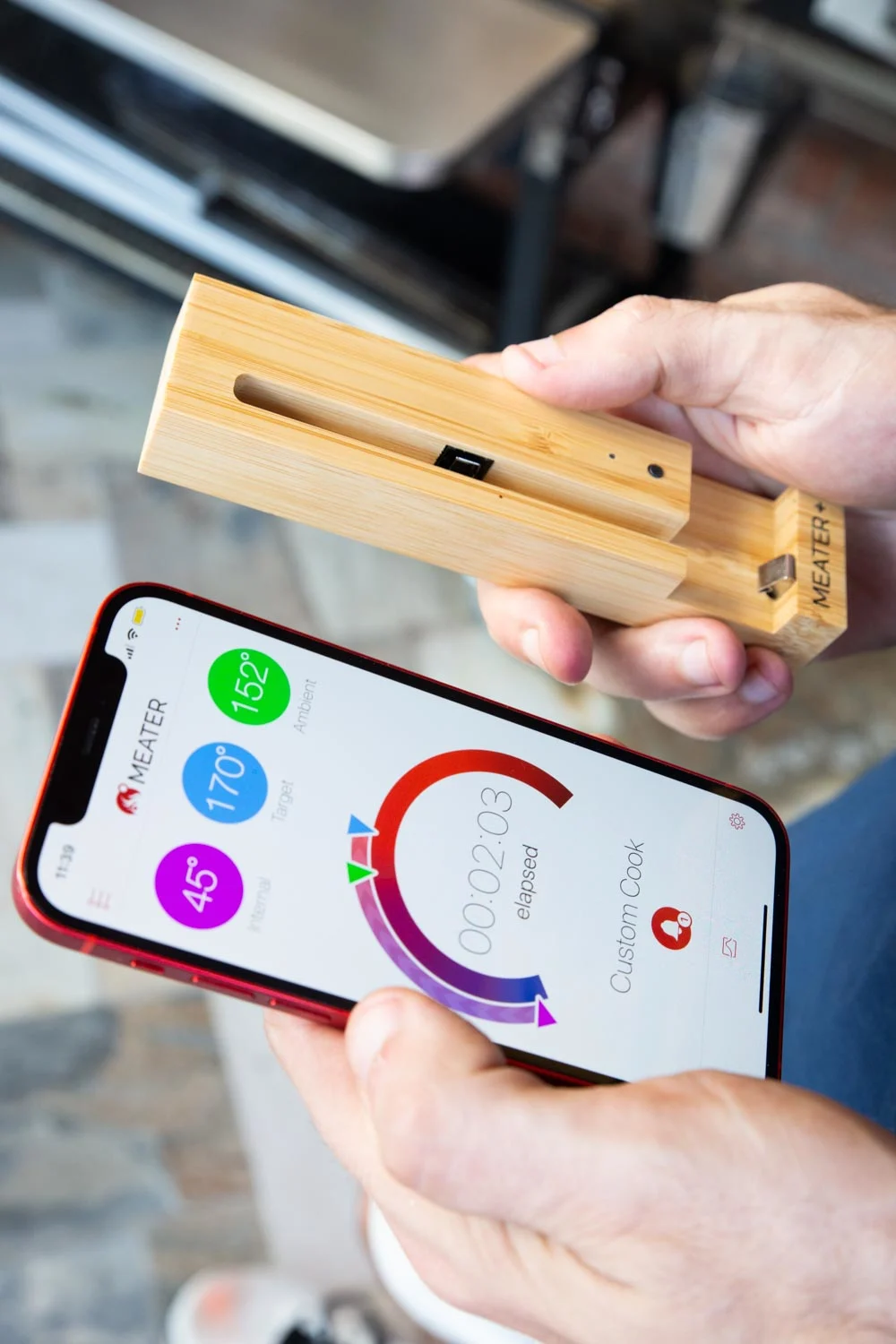
This is where we typically see people make mistakes—they smoke the roast for a certain amount of time (whatever a favorite cooking website tells them to do) but ignore the internal temperature of the meat, and this can be the difference between a great smoked chuck roast and a dry smoked chuck roast.
The meater probe thermometer allows us to monitor the temperature of the chuck roast itself, without having to open the smoker and lose the built-up heat and smoke. Probing the meat really helps you navigate through the cook without feeling anxious and achieve swift delicious results.
And as for the temperature of the chamber, you probably already have a thermometer on your smoker giving you readings of the internal chamber temperature. Knowing the temperature in the chamber and within the chuck roast tells you exactly what is going on in there without opening and looking for yourself.

If you’re looking, you’re not cooking! You’ve heard this phrase hundreds of times if you’ve watched barbecue YouTube. (You are watching it right?! Check out our channel right here.)
Although this an overused phrase, it’s very true and your choice of thermometer should support your efforts to monitor the meat you are cooking, as well as the internal temperature of the smoker.
Place the meat in the chamber and maintain the chamber at 225°-250°. You may spritz the chuck roast with apple juice, apple cider vinegar, or water once every 30-45 minutes if desired.
Once your probe thermometer shows the internal temperature of the chuck roast at 170° it’s time to wrap it. By this point, your chuck roast will have developed an amazing bark that we lovingly call “Bark Candy”.
This Bark Candy provides the most amazing flavor to any meat, including your chuck roast. And this is the reason we absolutely do not go overboard with our rub while prepping our meat. To preserve this bark candy, our favorite way to wrap is to double-wrap our beef chuck roast in pink butcher paper, instead of aluminum foil.
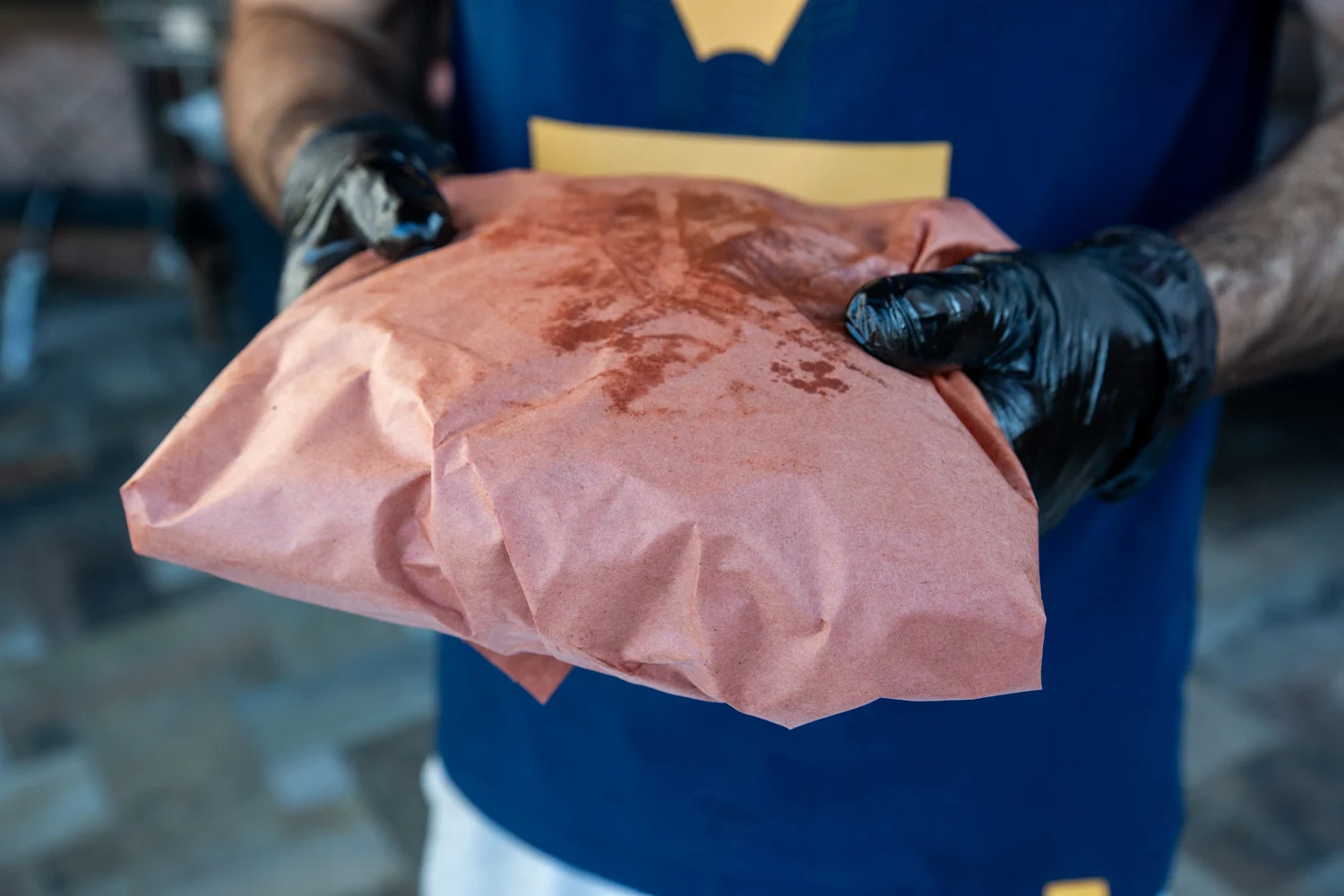
Pink butcher paper does 2 things for us.
First, it helps to seal in juices that allow our chuck roast to stay nice and moist.
Second, it allows some steam to escape which allows our Bark Candy to stay intact.
If you wrap your chuck roast in aluminum foil, it will trap all of the steam and you’ll have a nice, juicy pot roast—not the smoked beef chuck roast you are craving. (You’ll be upset with the time you wasted, and you’ll vow to not do that, next time. You really might as well have thrown the roast into a braising liquid like beef broth or beef stock.)
Now that we know what to wrap our chuck roast with (pink butcher paper) and what not to wrap it with (aluminum foil) the next internal temperature of the meat we’re going to take the chuck roast to is 195° internal temperature (smoker chamber temperature at 225°).
A Note On Temperature To Pull Your Meat:
Many recipes will take their chuck roast temperature up to 190° or 203° and sometimes even to 205°. The problem is the carryover heat will cause the 203° and 205° temps to go even higher, and that could potentially dry out your meat.
By taking your meat to 195°, the carryover heat will take us right around that magical 203° that gives us the perfect combination of tenderness and doneness. You should experiment with your specific smoker to find the sweet spot for your setup.
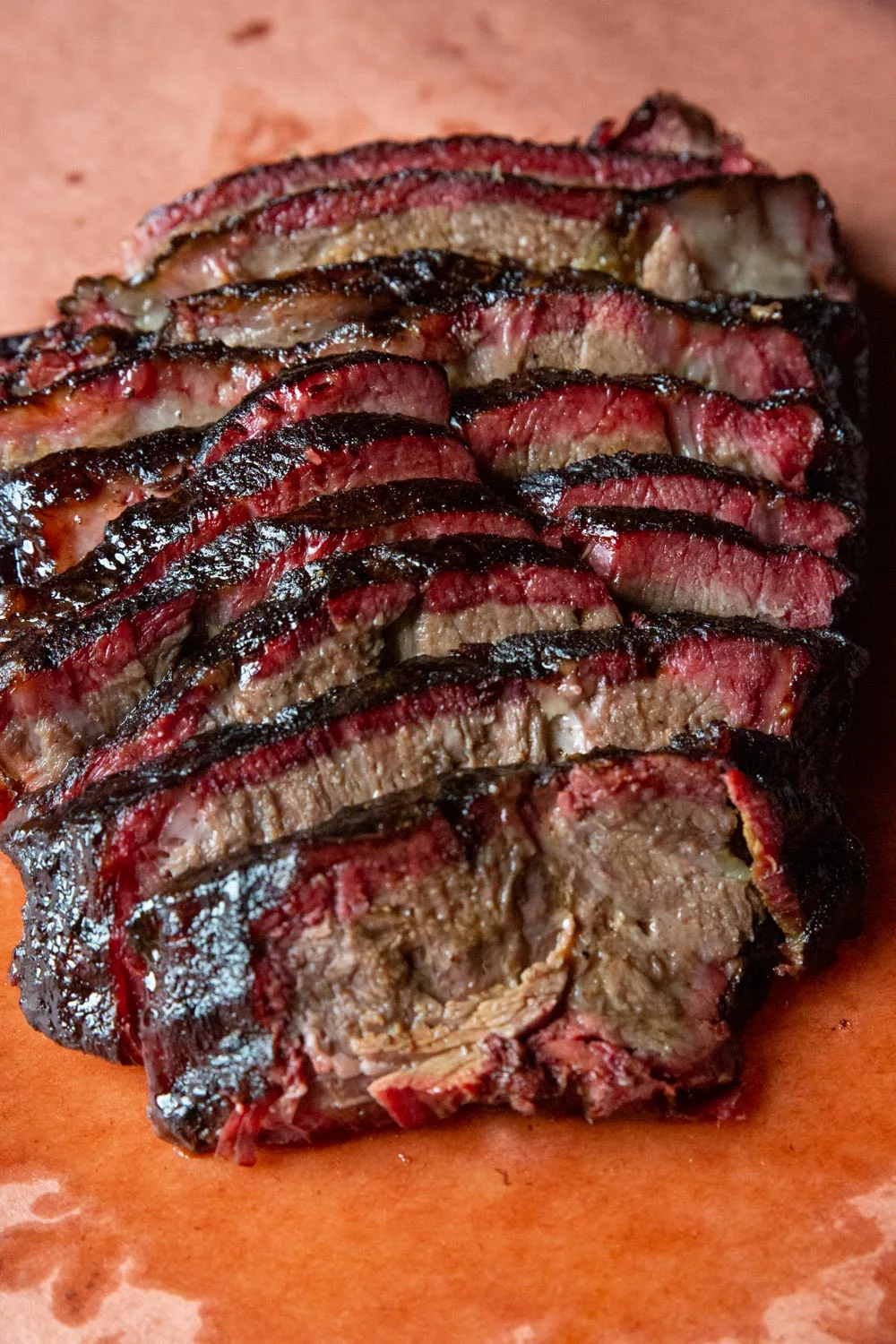
Resting the Wrapped Chuck Roast (Oven vs. Igloo Cooler)
Okay, your wrapped chuck roast has continued on its journey and has finally reached approximately 195° internal temperature. I bet it smells divine. Now it’s time to rest.
At this point, we’re going to turn our pellet smoker temperature to the low setting which is 180°. You smoker isn’t even mandatory at this point of the cook anyways!
Wait, did I just say the smoker is no longer needed? That is correct. This part of the cook can be done in an oven because the smoke has already done its job of providing flavor and aroma.
While the meat is still wrapped and the probe still in place, you can rest your chuck roast in your kitchen oven or smoker at a temperature of 180°.
The reason we’re doing this is the intramuscular fat and connective tissue will continue melting as the meat relaxes between 170°-180°. You can do this for 1-2 hours.
Alternatively, some cooks will take the wrapped meat and place it in an igloo cooler wrapped in paper towels and leave it for 1-3 hours. This rests the meat and allows intramuscular fat to continue melting.
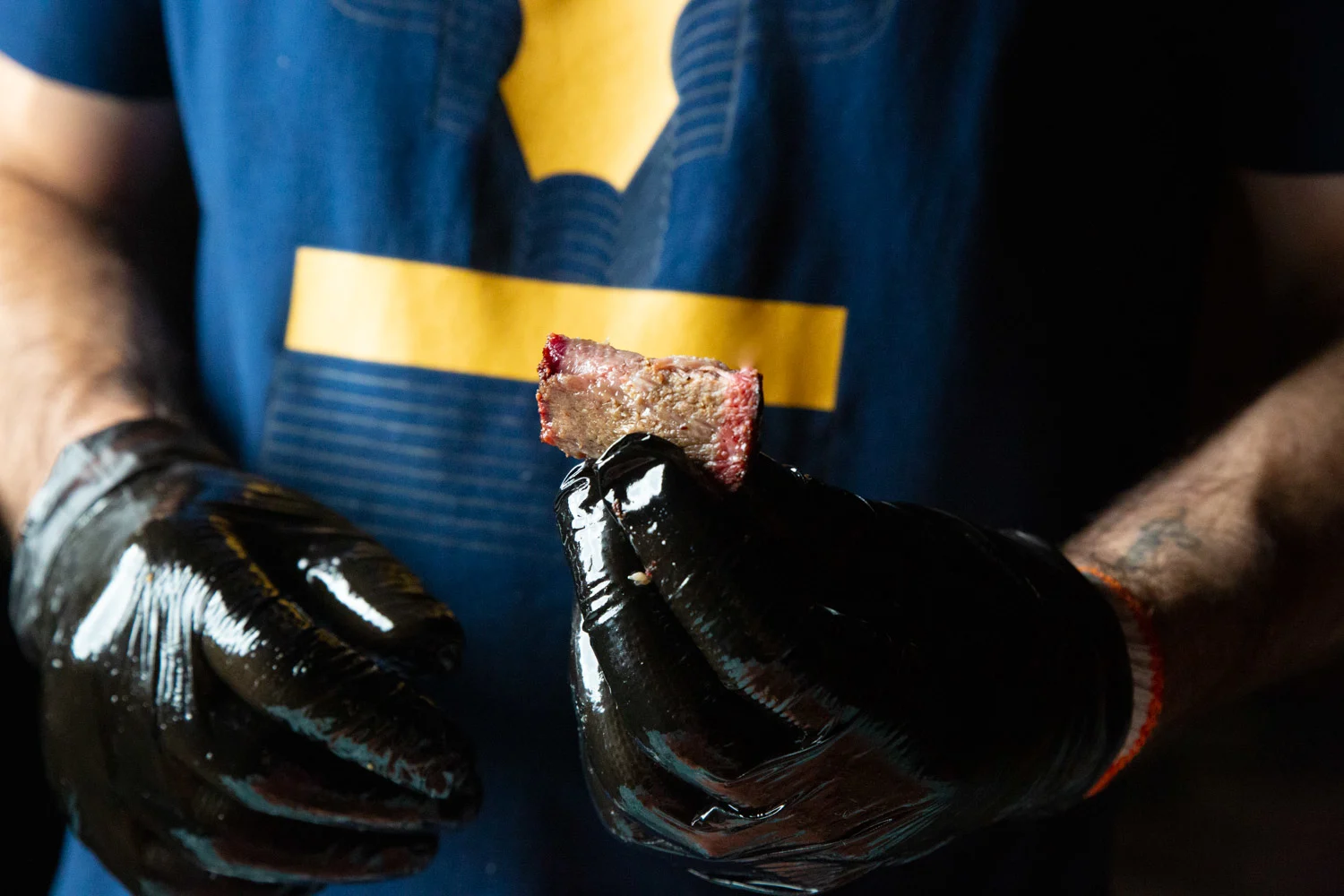
How To Slice Smoked Chuck Roast
Now get out your cutting board because it’s time to slice your chuck roast against the grain. I always use this Cuisinart electric slicer for my large smoked beef cuts.
Sometimes this can be a little difficult because the grain will run in different ways. If you really want to be extra, you can cut/group it into smaller pieces to be able to consistently slice across the grain. Enjoy every tender morsel of your smoked beef chuck roast!
What Side Dishes Go With Smoked Meats?
For this smoked beef chuck roast, I recommend checking out these side dishes…
Houston Rodeo Blue Ribbon Potato Salad Recipe
Texas Cowboy Caviar Recipe (with Red Wine Vinegar)
Corn and Black Bean Salad with Mexican Vinaigrette
Have questions? Need help? Have an addition or a suggestion to a recipe? Drop me a comment below!
If you make this recipe, I would LOVE to see it!
Tag me on Instagram @UrbanCowgirl and use #UrbanCowgirl to be featured. 🙂
Follow us on Social Media using the links below!!
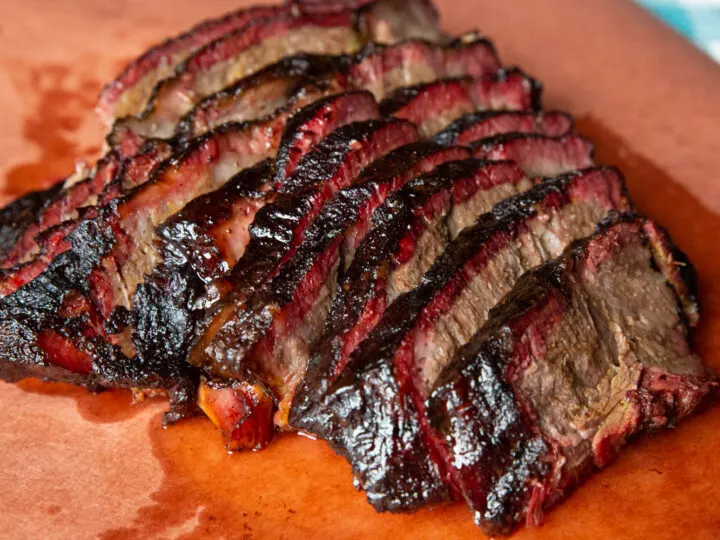
Ultra Juicy Smoked Beef Chuck Roast Recipe
A simple smoked chuck roast can be prepared like barbecue brisket for smaller households at a fraction of the cost. This recipe will share the techniques for an ultra juicy experience with a great smoke ring and fantastic beefy flavor!
Ingredients
- 3-4 lb. smoked chuck roast
- kosher salt
- black pepper
- onion powder
- garlic powder
- 1 c. apple juice, in a spray bottle
- 2 c. barbecue sauce for serving
Instructions
Remove chuck roast from the package, if you are going to do an overnight dry brine, sprinkle liberally with kosher salt and wrap in saran wrap, or place in a dish tented with foil. Dry brine for 12-24 hours. After the dry brine, remove and pat dry. Continue on with the recipe.
For the rub sprinkle the chuck roast liberally with salt and pepper first, then coat with onion powder and garlic powder. No measuring is needed just sprinkle directly from the shaker. Seasonings should be generous but meat should be able to peek through. (See photos or video for examples.)
Prepare your smoker and set it to 225 degrees for a pellet smoker, or maintain heat from 225- 250 degrees for a standard wood-burning smoker. Place the chuck roast in the smoker and probe the meat in its thickest part. Close the chamber and smoke to 170 degrees internal temperature, spritzing with apple juice every 30-40 minutes.
At 170 degrees, remove the chuck roast and wrap well in pink butcher paper. Place back into the smoker at 225 degrees, until the internal temperature hits 195.
Remove the chuck roast and place in the oven at 170-180 degrees for 1 hour, or rest in an igloo cooler (still inside the peach paper). The fat will continue to break down during this time giving you a very juicy chuck roast.
Remove from the oven (or igloo cooler) and rest an additional hour if you like, or slice it up immediately. Serve with barbecue sauce if desired.
Notes
If you get a smaller chuck roast than 4 pounds your time will be more than the listed 6 hours, plus resting. This is because the small chuck roast dehydrates and there is no water left to conduct heat. The stall begins earlier and we need to wrap it earlier to prevent drying out.
You may choose to smoke it for 2 hours and then wrap it in butcher paper or place it in an aluminum pan with a cup of beef broth and barbecue rub. Tent it with foil and then continue cooking.
Always cook to internal temperature, not a mandatory time frame. Cook at 225 degrees until the meat is 145-150 degrees for these smaller roasts, then wrap and continue cooking to 190-195 degrees. Rest as long as you can before serving.
Nutrition Information:
Yield:
20Serving Size:
1/2 lbAmount Per Serving: Calories: 697Total Fat: 42gSaturated Fat: 17gTrans Fat: 2gUnsaturated Fat: 22gCholesterol: 226mgSodium: 508mgCarbohydrates: 13gFiber: 0gSugar: 10gProtein: 67g
This nutritional information is provided as a courtesy as an estimate only. Consult with a dietician for precise estimates. This website makes no claims that the nutritional values listed are accurate.

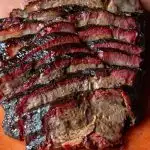

Lyn
Monday 30th of October 2023
I want to add to my post that everyone that tasted my no rub brisket and ribs, absolutely loved it and one couple travels the US tasting BBQ and they said if not the best it was one of the best they ever tasted. Their job requires coast to coast travel, during their travels they eat BBQ at different places.
Lyn
Monday 30th of October 2023
I smoked a brisket for 3 hours before adding any rub. After 3 hours I pulled the brisket out and applied the rub, seasoned salt, coarse black pepper, onion powder, garlic powder, chili powder. I honestly think it enhanced the smoke flavor and still had a very nice bark. Now on the flip side. I first started smoking brisket, ribs, etc 15 years ago and used no rubs, of any type, dry or wet. I took the brisket out of the Cryovac and straight on the smoker. No trimming, no rubs, wet or dry, out of package and in the smoker. I smoked at 150* for 20 hours, put the brisket in a deep, long SS pan covered air tight with extra heavy duty foil for 4 hours at 250 degrees. and to this day it is still the best tasting I have ever had, you get total meat and smoke flavor without all the rigamore.
Guy
Wednesday 27th of September 2023
Hi. So over 3 paragraphs you espouse the idea of "if you lookin, you ain't cookin"... Then the next paragraph suggests spritzing very 40mins... How does that reconcile? Serious question by the way, not being smart arse
Sarah Penrod
Monday 16th of October 2023
Open chamber, spritz, close chamber, walk away. Should take less than 8 seconds. In the beginning of your journey you will want to look at the meat, ask your family to look at the meat, take pictures with your cell phone, etc. LOL We all do it. But this drops the temperature and humidity in the chamber and it can take 30 minutes to return to the temperature it was at before you opened it. So, just keep it brief. It's always a balance between looking and learning versus keeping the chamber hot and humid. You'll get the hang of it after awhile.
Bruce
Tuesday 29th of August 2023
Can I go through all the steps except for slicing, refrigerate and slice and heat the next day.
Sarah Penrod
Monday 16th of October 2023
If you reheated in an oven and add 1 cup of beef broth that would work.
MB
Thursday 17th of August 2023
Used your recipe for 2.5lb prime chuck roast. It was fantastic! At 3 hours in it hit 190F. I wrapped it in brown paper (it was all I had) it immediately dropped to 160. Put it back on the grill for 45 minutes and it came up to 200. I pulled it and wrapped in newspapers for an hour, then we ate. Man was it good! Really nice black bark on the outside and tender, greasy, goodness throughout. Thanks for the great guidance and well-written recipe! P.S. My smoker ran a little hot at 275.